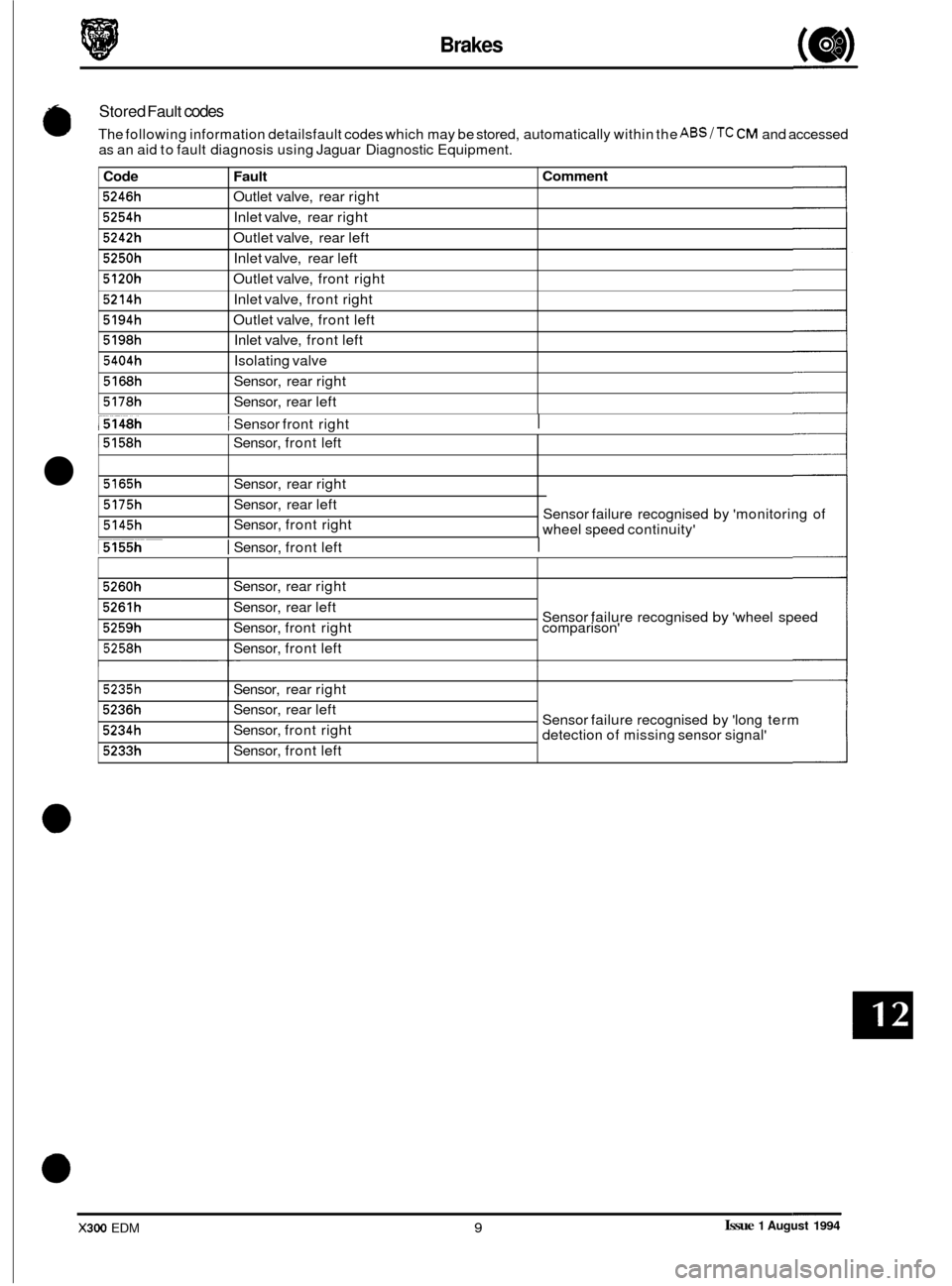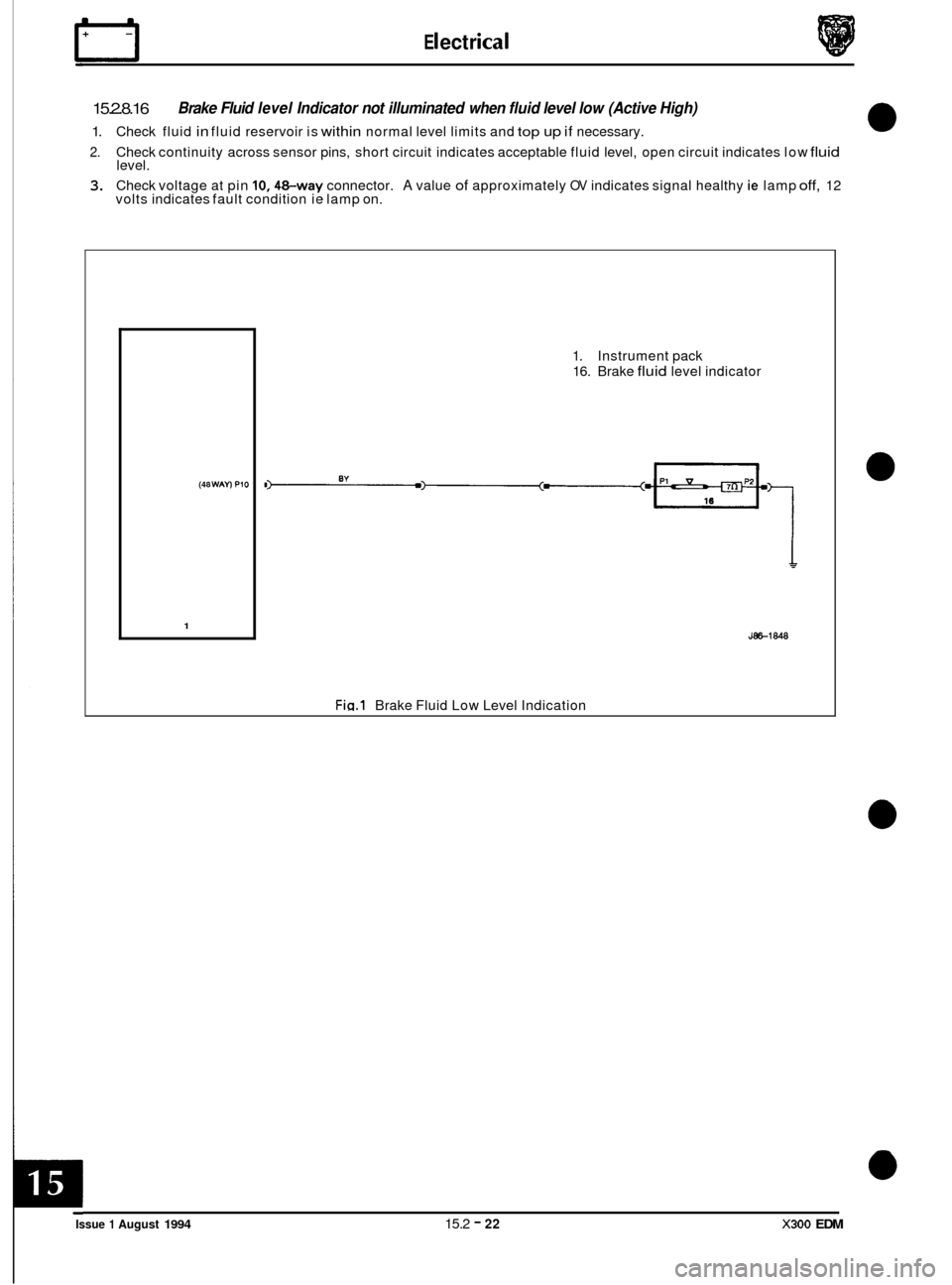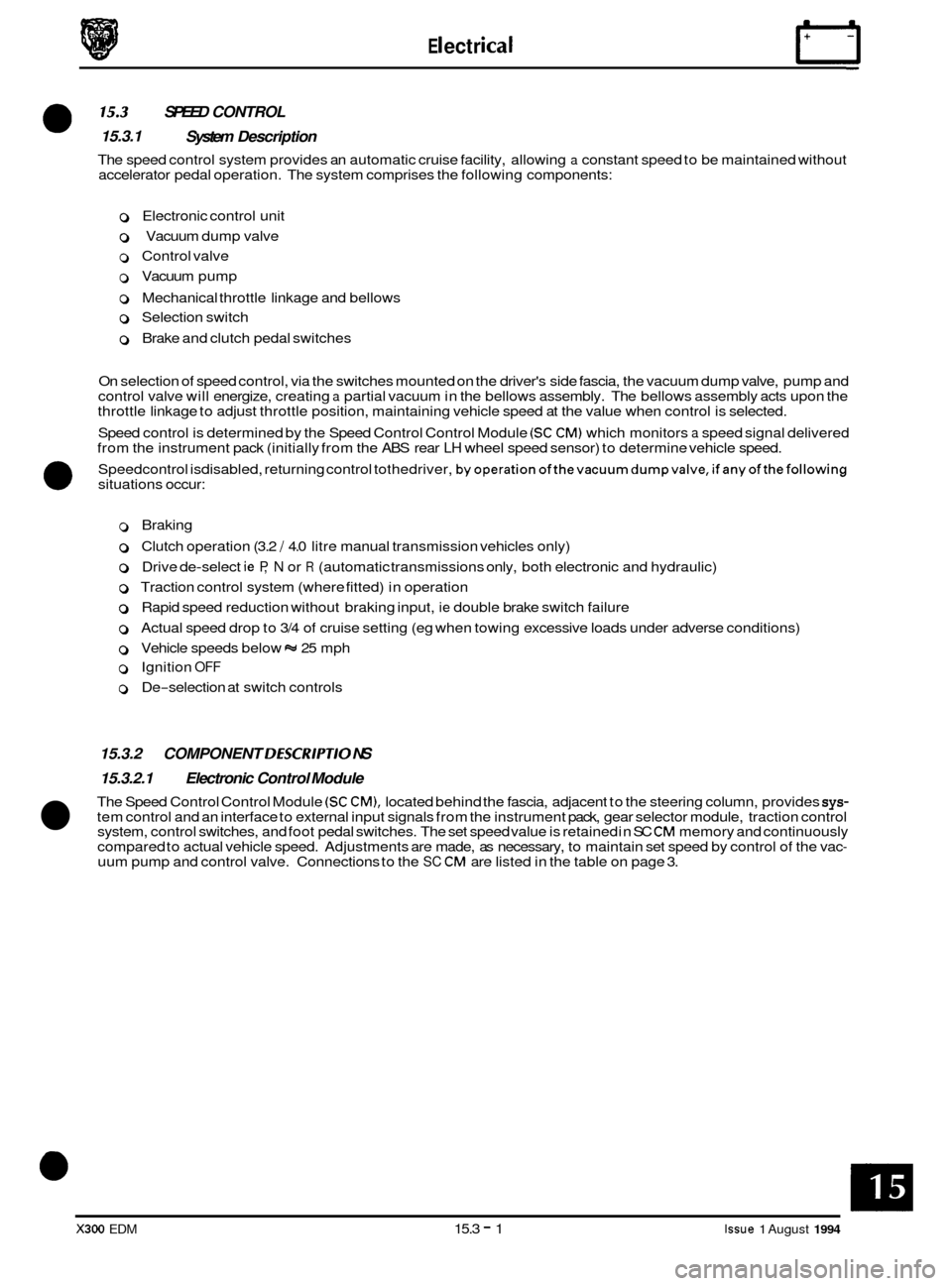brake sensor JAGUAR XJ6 1994 2.G Electrical Diagnostic Manual
[x] Cancel search | Manufacturer: JAGUAR, Model Year: 1994, Model line: XJ6, Model: JAGUAR XJ6 1994 2.GPages: 327, PDF Size: 13.73 MB
Page 72 of 327

(a) Brakes
Pin Point Tests
Wheel Sensor
The wheel sensors are connected across ABS / TC CM pins 5 - 12 inclusive, one sensor per pair of pins (see 'Control
Module Connections', page 3).
. Testing between pins of the 28 way multi-plug connector, checkthat the resistance of each sensor coil is 1.1kQ (toler- ance of * 50%).
Hydraulic Pump Motor
rn Disconnect the pump motor bi-pin connector.
rn Check the resistance value of the motor winding is approximately 0.m.
Throttle position sensor
With the vehicle ignition ON, test the throttle position sensor harness between ABSITC CM pins 25 and 27. Avoltage
of 5V (k 0.5V) should be recorded.
Repeat the test between ABS
/ TC CM pins 26 and 27 with the accelerator pedal pressed down approximately half
of full travel. Avoltage of approximately half the first value should be recorded. Variation in accelerator pedal posi- tion should cause a varying voltage value to be recorded.
Throttle Flap Actuator Motor
. Test the throttle flap actuator motor between ABS /TC CM multi-plug connector pins 16 and 17. A resistance value
of 1.651 should be recorded.
Brake Switch
. Measure the voltage at the brake switch between ABS /TC CM pin 20 and ground. With pedal UP, ie not operated,
a reading equivalent to battery voltage should be achieved. Operate brake pedal fully ensuring coinciding ground,
ie
0 volts, through switch.
Traction Switch
Check continuity of traction OFF / ON switch between ABS /TC CM pin 18 and ground. Operate switch ensuring CO- inciding short circuit.
Issue 1 August 1994 8 X300 EDM
Page 73 of 327

Brakes
Code Fault
5246h Outlet valve, rear right
5254h Inlet valve, rear right
5242h Outlet valve, rear left
5250h Inlet valve, rear left
5120h Outlet valve, front right
5214h Inlet valve, front right
5194h Outlet valve, front left
5198h Inlet valve, front left
5404h Isolating valve
5168h Sensor, rear right
5178h Sensor, rear left
Stored Fault codes
The following information detailsfault codes which may be stored, automatically within the ABS/TC CM and accessed
as an aid to fault diagnosis using Jaguar Diagnostic Equipment.
Comment
r5148h 1 Sensor front right I
5158h Sensor, front left
5165h Sensor, rear right
5175h
5145h
Sensor, rear left
Sensor, front right Sensor
failure recognised by 'monitoring of
wheel speed continuity'
Fi&h- I Sensor, front left I
5260h
5261h
5259h
5258h
Sensor, rear right
Sensor, rear left
Sensor, front right comparison'
Sensor, front left Sensor
failure recognised
by 'wheel speed
1--- r- I
5236h
5234h
5233h
5235h I Sensor, rear right
Sensor, rear left
Sensor, front right
Sensor, front left Sensor
failure recognised by 'long term
detection of missing sensor signal'
Issue 1 August 1994 X300 EDM 9
Page 79 of 327

Climate Control Systems
14.2.3 Solar Sensor (Fig. 1)
The solar sensor is mounted on top of the facia, between the
facia defrost grilles.
The sensor isconstructed around
a photo-diode to measure
direct sunlight. The sensor provides an output response sig-
nal totheA1CCM;thisensuresthe in-cartemperaturestabil- ity whilst reducing outlet temperature to compensate for
solar load heating. The solar sensor is fitted to aircondition- ing vehicles only.
14.2.4 Engine Speed Signal
The A 1 CCM receives an engine speed signal from the En- gine Control Module (ECM).
This signal facilitates compressor lock sensing (12 cyl. ve- hicles only).
This signal also aids the A
1 CCM inhibition of the heated
screen relays. At engine speeds lower than 800 RPM the A I CCM assumes poor idle or engine not running and will not
permit the selection of the heated screens.
14.2.5 Ambient Temperature Sensor (Fig. 2)
The ambient temperature sensor is located within the LH
brake cooling duct.
The sensor detects exterior airtemperature and provides the
A
I CCM with a signal to allow compensation for ambient
conditions.
The A
1 CCM is then capable of informing the control panel of the ambient air temperature in both Centigrade and
Fahrenheit, and updates the information every four
seconds.
The sensor is damped and
so does not detect temperature
fluctuations as quickly as other temperature sensors. This
facility prevents temporary temperature fluctuations affec
- ting overall temperature control.
14.2.6 Vehicle Speed Signal
The A 1 CCM receives a road speed signal from the instru- ment pack, derived from the ABS 1 TC CM.
This signal is required to control the blower fan speed to mi
- nimise the effects of ram air, i.e. blower fan speed changes
in proportion to vehicle road speed.
The signal also determines the frequency
at which the ambi- ent air temperature is updated. The road speed compensa-
tion for blower control is inhibited when the selected
temperature is 'LO (maximum cooling) and 'HI' (maximum
heating) and defrost mode.
14.2.7 Evaporator Temperature Sensor
Located next to the evaporator fins, the sensor detects the air temperature leaving the evaporator, and sends this sig- nal to the A 1 CCM.
When the temperature approaches
OOC, the A 1 CCM disen-
gages the compressor to prevent freezing conditions. When
thetemperature rises above3OC.theAlCCM re-engagesthe
compressor.
J82-L06 Fig. 1
Fig. 2
0
0
Issue 1 August 1994 4 X300 EDM
Page 155 of 327

Electrical rl
JOS 1776
1. Instrument Pack 7. Powerwash Relay
2. Body Processor Unit
(BPU) 8. Washer Fluid Level Sensor
3. Oil Pressure Sensor 9. Brake Fluid Level Sensor
4. Coolant Level Sensor 10. Ignition Switch 5. Coolant Temperature Sensor 11. Column Switch
6. Coolant Recirculation Pump Relay 12. Fuel Tank Level Sensor
Fig. 1 Component Location Diagram
Page 175 of 327

rl E I ect r ical
15.2.8.16
1. Check fluid in fluid reservoir is within normal level limits and top up if necessary.
2. Check continuity across sensor pins, short circuit indicates acceptable fluid level, open circuit indicates low fluid level.
3. Check voltage at pin 10,48-way connector. A value of approximately OV indicates signal healthy ie lamp off, 12
volts indicates fault condition ie lamp on.
Brake Fluid level Indicator not illuminated when fluid level low (Active High)
(48 WAYl P10
1
1. Instrument pack
16. Brake
fluid level indicator
J86-1848
Fia.1 Brake Fluid Low Level Indication
0
0
0
0
Issue 1 August 1994 15.2 - 22 X300 EDM
Page 178 of 327

E I ect r ical IT
SPEED CONTROL
System Description
0 15.3 15.3.1
The speed control system provides an automatic cruise facility, allowing a constant speed to be maintained without
accelerator pedal operation. The system comprises the following components:
0 Electronic control unit
0 Vacuum dump valve
0 Control valve
0 Vacuum pump
0 Mechanical throttle linkage and bellows
0 Selection switch
0 Brake and clutch pedal switches
On selection of speed control, via the switches mounted on the driver's side fascia, the vacuum dump valve, pump and
control valve will energize, creating
a partial vacuum in the bellows assembly. The bellows assembly acts upon the
throttle linkage to adjust throttle position, maintaining vehicle speed at the value when control is selected.
Speed control is determined by the Speed Control Control Module
(SC CM) which monitors a speed signal delivered
from the instrument pack (initially from the ABS rear LH wheel speed sensor) to determine vehicle speed.
Speedcontrol isdisabled, returning control tothedriver,
byoperationofthevacuumdumpvalve,ifanyofthefollowing situations occur: 0
0 Braking
0 Clutch operation (3.2 / 4.0 litre manual transmission vehicles only)
o Drive de-select ie P, N or R (automatic transmissions only, both electronic and hydraulic)
0 Traction control system (where fitted) in operation
0 Rapid speed reduction without braking input, ie double brake switch failure
0 Actual speed drop to 3/4 of cruise setting (eg when towing excessive loads under adverse conditions)
0 Vehicle speeds below w 25 mph
0 Ignition OFF
0 De-selection at switch controls
15.3.2 COMPONENT DESCRlPTlO NS
15.3.2.1 Electronic Control Module
The Speed Control Control Module (SC CM), located behind the fascia, adjacent to the steering column, provides sys- tem control and an interface to external input signals from the instrument pack, gear selector module, traction control
system, control switches, and foot pedal switches. The set speed value is retained in SC CM memory and continuously
compared to actual vehicle speed. Adjustments are made, as necessary, to maintain set speed by control of the vac- uum pump and control valve. Connections to the SC CM are listed in the table on page 3.
X300 EDM 15.3 - 1 Issue 1 August 1994